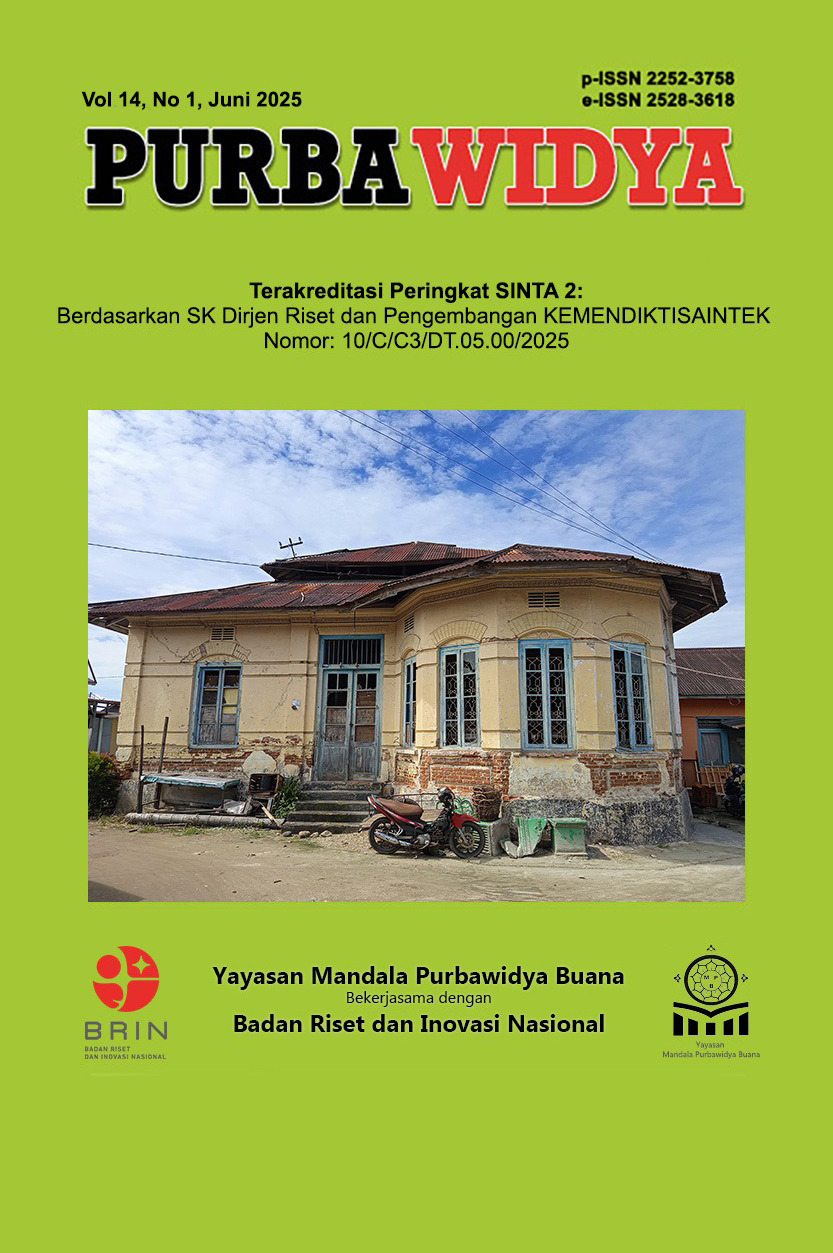Medan Translasi Pada Pemetaan Artefak Kebudayaan Berupa Produk Kerajinan
Main Article Content
Abstract
This paper aims to present theoretical findings related to the translation field in relation to efforts to reveal the value of the intangibility of cultural artifacts in the form of craft products. The theoretical findings here are ideas obtained when carrying out re-readings that are being carried out (work-in-progress) based on the findings of two previous studies on the manifestation of artifacts that focus on the aspect of human-technology interaction and its interpretation. The re-reading of the two previous research findings is qualitative interpretative in nature that focuses on the translation mode in the process of producing craft products. This re-reading attempts to find the position of the translation field as a complement to awareness when revealing the value of the intangibility of craft products. The findings of this re-reading are expected to be an inspiration for developing a tool that can assist in research activities into craft products and/or cultural artifacts based on the dynamics of cultural translation.
Article Details

This work is licensed under a Creative Commons Attribution-NonCommercial-ShareAlike 4.0 International License.
Authors who publish with this journal agree to the following terms:
- Authors retain copyright and grant the journal right of first publication with the work simultaneously licensed under Creative Commons Attribution-NonCommercial-ShareAlike 4.0 International License that allows others to share the work with an acknowledgement of the work's authorship and initial publication in this journal.
- Authors are able to enter into separate, additional contractual arrangements for the non-exclusive distribution of the journal's published version of the work (e.g., post it to an institutional repository or publish it in a book), with an acknowledgment of its initial publication in this journal.
- Authors are permitted and encouraged to post their work online (e.g., in institutional repositories or on their website) prior to and during the submission process, as it can lead to productive exchanges, as well as earlier and greater citation of published work (See The Effect of Open Access).
References
Appelbaum, Paul S., Erik Parens, Sara M. Berger, Wendy K. Chung, and Wylie Burke. 2020. “Is There a Duty to Reinterpret Genetic Data? The Ethical Dimensions.” Genetics in Medicine 22 (3). https://doi.org/10.1038/s41436-019-0679-7.
Arantes, Antonio. 2019. “Safeguarding. A Key Dispositif of UNESCO’s Convention for the Safeguarding of Intangible Cultural Heritage.” Vibrant Virtual Brazilian Anthropology 16. https://doi.org/10.1590/1809-43412019v16a201.
Brown, Sass, and Federica Vacca. 2022. “Cultural Sustainability in Fashion: Reflections on Craft and Sustainable Development Models.” Sustainability: Science, Practice, and Policy 18 (1). https://doi.org/10.1080/15487733.2022.2100102.
Darmawan, Ruly. 2010. “Web 2.0 and Idiosyncrasy of Cultural Heritage: A Perspective from Indonesia.” In Handbook of Research on Technologies and Cultural Heritage: Applications and Environments. https://doi.org/10.4018/978-1-60960-044-0.ch024.
Darmawan, Ruly, and July Hidayat. 2018. “THE ‘THREE-MILLIMETERS’: A TECHNOCULTURAL REFLECTION ON BAMBOO WEAVING CRAFT DEVELOPMENT.” Jurnal Sosioteknologi 17 (1). https://doi.org/10.5614/sostek.itbj.2018.17.1.4.
ERGUVAN, Mehmet. 2021. “Increasing Visibility of the Turkish Fans of South Korean Popular Culture through Translation.” Çeviribilim ve Uygulamaları Dergisi 2021 (30). https://doi.org/10.37599/ceviri.904565.
Esfandiari, Mohammad Reza, Tengku Sepora, and Tengku Mahadi. 2015. “Translation Competence: Aging Towards Modern Views.” Procedia - Social and Behavioral Sciences 192. https://doi.org/10.1016/j.sbspro.2015.06.007.
Fernández Bellver, David, M. Belén Prados-Peña, Ana M. García-López, and Valentín Molina-Moreno. 2023. “Crafts as a Key Factor in Local Development: Bibliometric Analysis.” Heliyon. https://doi.org/10.1016/j.heliyon.2023.e13039.
Friel, Martha. 2020. “Crafts in the Contemporary Creative Economy.” Aisthesis (Italy) 13 (1). https://doi.org/10.13128/Aisthesis-11599.
Groth, Camilla, Katherine Townsend, Tina Westerlund, and Gunnar Almevik. 2022. “Craft Is Ubiquitous.” Craft Research. https://doi.org/10.1386/crre_00076_2.
Iser, Wolfgang. 2019. “On Translatability.” Surfaces 4. https://doi.org/10.7202/1064971ar.
Jokilehto, Jukka. 2005. “Definition of Cultural Heritage: References to Documents in History.” ICCROM Working Group “Heritage and Society,” no. January.
Jones, Kevin E., Kristof Van Assche, and John R. Parkins. 2021. “Reimagining Craft for Community Development.” Local Environment 26 (7). https://doi.org/10.1080/13549839.2021.1939289.
Kadarisman, A. Effendi. 2017. “Verbal Humor: A Salient Case in Translation and Translatability.” Jurnal Pendidikan Humaniora 5 (4). https://doi.org/10.17977/um030v5i42017p158.
Kendall, Laurel. 2014. “Intangible Traces and Material Things: The Performance of Heritage Handicraft.” Acta Koreana 17 (2). https://doi.org/10.18399/acta.2014.17.2.001.
Luckman, Susan. 2015. Craft and the Creative Economy. Craft and the Creative Economy. https://doi.org/10.1057/9781137399687.
Mamat, Roslina, Roswati Abdul Rashid, Rokiah Paee, and Normah Ahmad. 2022. “VTubers and Anime Culture.” International Journal of Health Sciences. https://doi.org/10.53730/ijhs.v6ns2.8231.
Marcotte-Chenard, Sophie. 2022. “The Critique of Historical Reason and the Challenge of Historicism.” Dialogue-Canadian Philosophical Review 61 (3). https://doi.org/10.1017/S0012217322000233.
Mbusi, Nokwanda P., and Kakoma Luneta. 2021. “Mapping Pre-Service Teachers’ Faulty Reasoning in Geometric Translations to the Design of Van Hiele Phase-Based Instruction.” South African Journal of Childhood Education 11 (1). https://doi.org/10.4102/sajce.v11i1.871.
Rȩdzioch-Korkuz, Anna. 2023. “Revisiting the Concepts of Translation Studies: Equivalence in Linguistic Translation from the Point of View of Peircean Universal Categories.” Language and Semiotic Studies 9 (1). https://doi.org/10.1515/lass-2022-0008.
Santabárbara Morera, Carlota. 2017. “Where Is the Authenticity of the Contemporary Art?” Ge-Conservacion 11. https://doi.org/10.37558/gec.v11i0.482.
Santos, Kristine Michelle L. 2021. “Localising Japanese Popular Culture in the Philippines: Transformative Translations of Japan’s Cultural Industry.” Border Crossings 13 (1). https://doi.org/10.22628/bcjjl.2021.13.1.93.
Stephanides, Stephanos, and Susan Bassnett. 2008. “Islands, Literature, and Cultural Translatability.” Transtext(e)s Transcultures 跨文本跨文化, no. Hors série. https://doi.org/10.4000/transtexts.212.
Sulistiyono, Singgih Tri. 2018. “Paradigma Maritim Dalam Membangun Indonesia: Belajar Dari Sejarah.” Lembaran Sejarah 12 (2). https://doi.org/10.22146/lembaran-sejarah.33461.
Yudianto, Erfan, Susanto Susanto, Toto’ Bara Setiawan, and Hidayatud Diyanah. 2021. “ETNOMATEMATIKA: KARAKTERISTIK BATIK BONDOWOSO DI RUMAH PRODUKSI KI RONGGO.” AKSIOMA: Jurnal Program Studi Pendidikan Matematika 10 (2). https://doi.org/10.24127/ajpm.v10i2.3542.
Zabulis, Xenophon, Nikolaos Partarakis, Ioanna Demeridou, Paraskevi Doulgeraki, Emmanouil Zidianakis, Antonis Argyros, Maria Theodoridou, et al. 2023. “A Roadmap for Craft Understanding, Education, Training, and Preservation.” Heritage 6 (7). https://doi.org/10.3390/heritage6070280.

